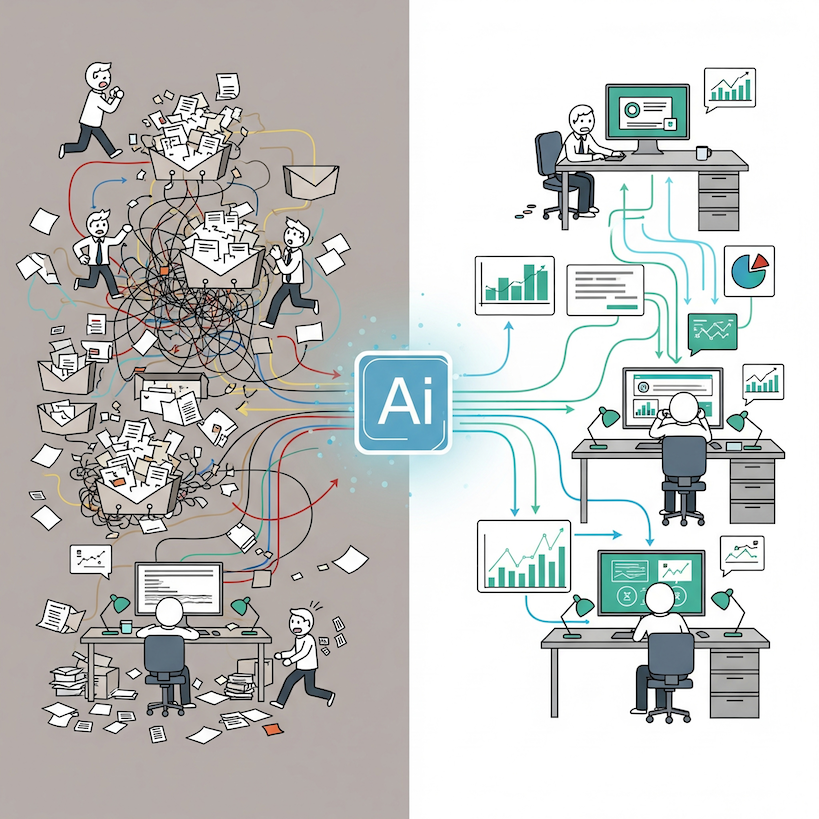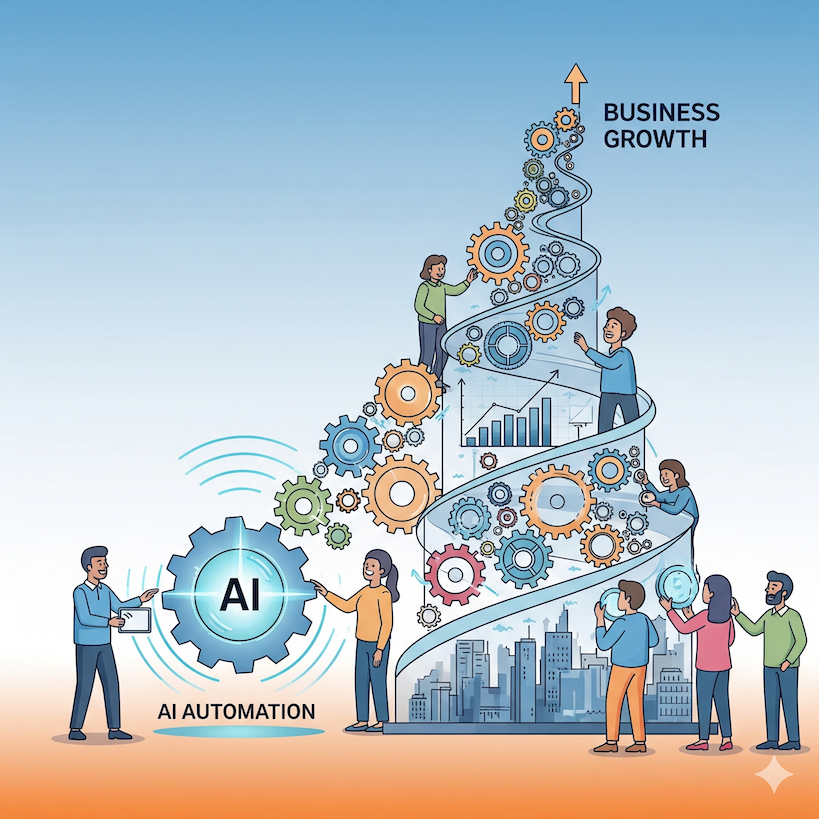
AI Workflows: From Chaos to Clarity
Organizations today are drowning in their own content. Businesses have never had more data at their disposal, yet employees struggle more than ever to find and use the right information. This paradox is costly: information overload wastes an estimated 28 billion hours annually, equating to nearly $1 trillion in lost productivity in the US economy alone.
The answer isn’t producing more content or building bigger storage systems—it’s rethinking how we interact with information through artificial intelligence (AI).
AI has moved far beyond simple chatbots. It now powers knowledge workflows that directly address real business challenges:
-
Automated Tagging & Classification – AI systems achieve up to 98% accuracy, saving teams as much as 30 hours per week per person by reducing manual data handling.
-
AI-Powered Virtual Assistants – Handling billions of customer interactions with near-perfect resolution rates, they free human agents to focus on high-value cases.
-
Intelligent Search & Discovery – Context-aware engines deliver precise answers in seconds, replacing time-consuming document hunts.
These are not distant promises—they’re available today, affordable, and accessible even to non-technical teams.
The answer isn’t producing more content or building bigger storage systems—it’s rethinking how we interact with information through artificial intelligence (AI).

The Content Management Crisis
Fragmentation and Outdated Systems
Fragmentation and Outdated Systems
Most organizations run on scattered, inconsistent documentation. Over half use three or more content management systems, and nearly a quarter juggle five or more. This fragmentation creates silos, trapping critical knowledge in platforms that don’t communicate.
The challenge isn’t just too many tools—it’s the absence of unified practices. Outdated documents and inconsistent standards force employees to waste time searching or recreating information. On average, knowledge workers lose 209 hours every year to repetitive, low-value tasks—time that could be invested in higher-value work.
Drowning in Content, Starving for Knowledge
Modern workplaces resemble digital mazes: wikis, PDFs, email threads, shared drives, Slack channels, and more. The irony is striking—while content has never been more abundant, actionable knowledge remains scarce.
This chaos undermines the very promise of content management systems—better collaboration, faster workflows, and easier access to knowledge. Instead, employees spend valuable hours searching, switching between systems, and duplicating efforts.
The Human Cost of Inefficient Workflows
The impact extends beyond lost productivity. Studies show that 41% of knowledge workers’ time goes to tasks that could be automated, while 67% of executives admit their teams are overwhelmed by information overload.
The cost is human as well as financial: rising frustration, creeping burnout, and missed opportunities to innovate. Over time, inefficiency becomes a cultural burden—slowing decisions, sapping morale, and eroding organizational agility.

Where AI Transforms Workflows
Smarter Search with RAG
Traditional search tools rely on keywords, often missing nuance and intent. Retrieval-Augmented Generation (RAG)changes the game.
RAG systems merge the broad reasoning power of large language models with real-time access to organizational data. They continuously index and refresh content, retrieve context-rich results, and transform them into precise, conversational answers.
Instead of sifting through PDFs or SharePoint folders, employees can simply ask:
“What’s our remote work expense policy?”
And receive an up-to-date, authoritative answer—instantly.
AI Assistants That Do Real Work
Forget basic chatbots. Modern AI assistants summarize documents, extract insights, draft responses, and recommend actions based on organizational knowledge.
-
Zendesk uses generative AI to suggest customer support replies drawn from internal resources—saving agents time while maintaining tone and accuracy.
-
n8n, a no-code automation platform, lets teams embed AI directly into workflows—for example, analyzing customer messages, routing them to the right channel, and drafting personalized responses. This reflects the same no-code accessibility highlighted earlier, showing how powerful AI can be when non-technical users bring it into everyday processes.
These assistants don’t just respond to queries—they accelerate decision-making and free humans to focus on complex, judgment-driven work.
Automating the Tedious
One of AI’s most immediate wins is automated tagging and classification, eliminating repetitive manual work while ensuring consistency at scale.
-
Diesel leveraged Vue.ai to automate product tagging, generating 22,300 tags with 98% accuracy and saving 30 hours per week.
-
Organon, a pharmaceutical leader, deployed Lyriko’s AI tagging across 60+ markets, classifying 30,000 promotional materials in multiple languages with 98% accuracy.
Beyond tagging, AI predicts content gaps, optimizes formatting, and monitors usage patterns—making repositories more dynamic, searchable, and relevant over time.
These assistants don’t just respond to queries—they accelerate decision-making and free humans to focus on complex, judgment-driven work.

Real-World Success Stories
REAL-WORLD SUCCESS STORIES
Bank of America’s Erica
As of 2025, Erica, Bank of America’s AI assistant, has handled more than 2 billion interactions, resolving 98% of queries without human input. That translates into millions of calls, emails, and chats redirected away from human agents—freeing staff for higher-value, relationship-driven work.
Diesel’s Documentation Transformation
Before adopting Vue.ai, Diesel’s seasonal product onboarding relied on slow, manual tagging and cataloging. With AI-powered tagging, the company now saves hours per launch while standardizing attributes across its global catalog, dramatically accelerating time-to-market.
Organon’s Scalable Solution
In highly regulated industries like pharmaceuticals, consistency and compliance are critical. Organon integrated Lyriko’s AI tagging system directly with Veeva PromoMats, ensuring every promotional material is accurately tagged, searchable, and compliant—accessible to teams worldwide.
Knowledge Managers Building FAQs
Tools like Document360 and BetterDocs demonstrate how AI can automatically generate FAQs from existing articles. Instead of spending hours manually curating lists, knowledge managers can now instantly produce structured, evolving FAQs that keep pace with their content libraries.

The Path Forward: Start Small, Scale Up
Begin with Quick Wins
Adopting AI workflows doesn’t require massive organizational change. The most effective approach is incremental:
-
Automate simple tasks first – Start with repetitive jobs like sorting emails, summarizing documents, or tagging content.
-
Build confidence and skills – Early wins help teams gain trust in AI and grow internal expertise.
-
Expand strategically – Once ROI becomes clear, move toward multi-step, higher-value workflows.
Teams using AI report saving 3.6 hours per week and show 90% higher productivity compared to those without.
AI for Everyone (No Code Needed)
The line between technical and non-technical users is dissolving. No-code platforms like Zapier, Make, and n8n empower anyone to build AI workflows with drag-and-drop simplicity.
-
Prebuilt AI Integrations – Connect directly with models from OpenAI, Google Cloud AI, or Hugging Face without writing code, accelerating experimentation.
-
Workflow Automation – Apply AI to real work: text summarization, sentiment analysis, image recognition, or chat automation across tools like Slack, Notion, and Gmail.
-
Scalable & Inclusive – Start small with lightweight automations and scale into complex, enterprise-grade workflows—lowering barriers for individuals, startups, and large teams alike.
Advanced Workflows Are Now Accessible
What once required enterprise IT departments is now fully democratized:
-
Content & Marketing Automation – AI can draft campaign copy, design visuals, and schedule posts based on engagement data.
-
Natural Language Workflow Design – Tools like Zapier’s Copilot turn plain English prompts into complete automation flows.
-
Affordable Enterprise Power – Cloud platforms deliver enterprise-grade automation capabilities at a fraction of the cost, making them accessible to small teams and solo professionals.
Take Action Today
The future of work with AI doesn’t begin with massive transformation—it begins with the first experiment. Pick one repetitive task, automate it with a no-code AI tool, and scale from there. Small wins compound quickly into lasting productivity gains.